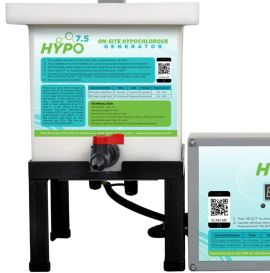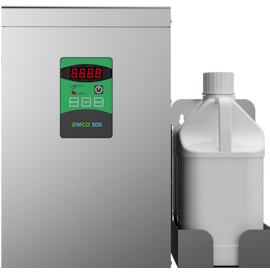연구 > 산업 > Health > 신청: Contact Surfaces
하이포아염소산 용액의 일반적인 이름
- Electrolytically Generated Hypochlorous Acid
- Neutral Electrolyzed Water (NEW)
- Electrolyzed Oxidizing Water (EOW)
- Electro-chemically Activated Water (ECA)
- Super-oxidized water (SOW)
결과: 6 게시된 기사

Microbe(s): influenza, coronavirus, SARS-CoV-2, COVID-19
Slightly acidic hypochlorous acid waters (SAHWs) with pH of 5.25.8 containing different concentrations of free available chlorine - 62, 119, 220, 300, and 540 ppm (SAHW-62, -119, -220, -300, and -540, respectively) - were evaluated for their virucidal activity toward a low pathogenic H7N1 avian influenza virus (AIV) and an infectious bronchitis virus (IBV) in suspension, abiotic carrier, and direct spray tests, with the presence of organic materials. In the carrier test, the plastic carriers, while viruses remained in the wipes. Besides, a small volume of sprayed SAHW was effective against the viruses on the rayon sheets for daily cleaning in the application area. The findings we obtained concerning IBV might basically be applicable in relation to SARS-CoV-2, given the resemblance between the two viruses.

Microbe(s): Total Microbial Count, methicillin-susceptible Staphylococcus aureus (MSSA), methicillin-resistant Staphylococcus aureus (MRSA)
This study aimed to monitor the microbiological effect of cleaning near-patient sites over a 48-hour period with a novel disinfectant, electrolyzed water. One ward dedicated to acute care of the elderly population in a district general hospital in Scotland. Lockers, left and right cotsides, and overbed tables in 30 bed spaces were screened for aerobic colony count (ACC), methicillin-susceptible Staphylococcus aureus (MSSA), and methicillin-resistant S. aureus (MRSA) before cleaning with electrolyzed water. Sites were rescreened at varying intervals from 1 to 48 hours after cleaning. Microbial growth was quantified as colony-forming units (CFUs) per square centimeter and presence or absence of MSSA and MRSA at each site. The study was repeated 3 times at monthly intervals. There was an early and significant reduction in average ACC (360 sampled sites) from a before-cleaning level of 4.3 to 1.65 CFU/cm2 at 1 hour after disinfectant cleaning (P <.0001). Average counts then increased to 3.53 CFU/cm2 at 24 hours and 3.68 CFU/cm2 at 48 hours. Total MSSA/MRSA (34 isolates) decreased by 71% at 4 hours after cleaning but then increased to 155% (53 isolates) of precleaning levels at 24 hours. Cleaning with electrolyzed water reduced ACC and staphylococci on surfaces beside patients. ACC remained below precleaning levels at 48 hours, but MSSA/MRSA counts exceeded original levels at 24 hours after cleaning. Although disinfectant cleaning quickly reduces bioburden, additional investigation is required to clarify the reasons for rebound contamination of pathogens at near-patient sites.

Microbe(s): Staphylococcus aureus
Staphylococcus aureus is a major pathogen. It can form biofilm on the surfaces of medical devices and food equipment, which makes it more difficult to eradicate. To develop a novel method to eradicate S. aureus biofilm, the effects of electrolyzed water on removing and killing S. aureus biofilm were investigated in this study. By using a biofilm biomass assay with safranin staining and visualization of biofilm architecture with scanning electron microscopy, it was shown that basic electrolyzed water (BEW) could effectively remove established biofilm. The pH of electrolyzed water affected removal efficacy. Using a biofilm viability assay with 3-(4,5-dimethylthiazol-2-yl)-2,5-diphenyltetrazolium bromide staining, acidic electrolyzed water (AEW) efficiently killed biofilm-imbedded S. aureus. The available chlorine in AEW may be a main contributing factor for bactericidal activity. Additionally, BEW had a removal efficacy for S. aureus biofilm equivalent to 2% NaOH, and AEW had a bactericidal capability for S. aureus in biofilm equivalent to 2% HCl. These data suggested that AEW and BEW could be applied as a bactericide and removing agent for S. aureus in biofilm, respectively.

Microbe(s): Viruses, Norovirus
Noroviruses (NVs) are the most frequent cause of outbreaks of gastroenteritis in common settings, with surface-mediated transfer via contact with fecally contaminated surfaces implicated in exposure. NVs are environmentally stable and persistent and have a low infectious dose. Several disinfectants have been evaluated for efficacy to control viruses on surfaces, but the toxicity and potential damage to treated materials limits their applicability. Sterilox hypochlorous acid (HOCl) solution (HAS) has shown broad-spectrum antimicrobial activity while being suitable for general use. The objectives of this study were to evaluate the efficacy of HAS to reduce NV both in aqueous suspensions and on inanimate carriers. HOCl was further tested as a fog to decontaminate large spaces. HOCl effectiveness was evaluated using nonculturable human NV measured by reverse transcriptase PCR (RT-PCR) and two surrogate viruses, coliphage MS2 and murine NV, that were detected by both infectivity and RT-PCR. Exposing virus-contaminated carriers of ceramic tile (porous) and stainless steel (nonporous) to 20 to 200 ppm of HOCl solution resulted in 99.9% ( 3 log10) reductions of both infectivity and RNA titers of tested viruses within 10 min of exposure time. HOCl fogged in a confined space reduced the infectivity and RNA titers of NV, murine NV, and MS2 on these carriers by at least 99.9% (3 log10), regardless of carrier location and orientation. We conclude that HOCl solution as a liquid or fog is likely to be effective in disinfecting common settings to reduce NV exposures and thereby control virus spread via fomites.

Microbe(s): Multiple
The study is designed to investigate bactericidal actions of electrolyzed oxidizing water on hospital infec-tions. Ten of the most common opportunistic pathogens are used for this study. Cultures are inoculated in 4.5 mL of electrolyzed oxidizing (EO) water or 4.5 mL of sterile deionized water (control), and incubated for 0, 0.5, and 5 min at room temperature. At the exposure time of 30 s the EO water completely inactivates all of the bacterial strains, with the exception of vegetative cells and spores of bacilli which need 5 min to be killed. The results indicate that electrolyzed oxidizing water may be a useful disinfectant for hospital infections, but its clinical application has still to be evaluated.

Microbe(s): Viruses, HIV
Electrolyzed products of a sodium chloride solution contain free residual chlorine and have been proved to be effective for disinfection. Electrolyzed strong acid water containing a low sodium chloride concentration (ESW-L) is prepared by the electrolysis of a solution containing a low sodium chloride concentration (0.1% or less). Although ESW-L has been confirmed to be an effective disinfectant, disinfective efficacy against dried HIV-1 and a target of ESW-L against HIV-1 have not been clarified. In this study, we attempted to demonstrate the efficacy of ESW-L against dried HIV-1 which relatively resists disinfection and to analyze disinfection target. We demonstrated that ESWL inactivated the infectivity of dried HIV-1. In the analysis of the mechanism of disinfection, although the HIV-1 structural protein, p24 within the virus particle, was not inactivated by ESW-L, the enzymatic activity of reverse transcriptase (RT) and genomic RNA within the particle, however, were inactivated after the treatment with ESW-L. These findings suggest that the enzymatic activity of RT and genomic RNA are the target of ESW-L.
Best Hypochlorous Acid (HOCL) Generators
 Portable Hypochlorous Acid (HOCL) Machine
Portable Hypochlorous Acid (HOCL) Machine
Make high quality hypochlorous acid in the home or office.
$159.99 + Free Shipping
 HOCL Machine + Electrostatic Sprayer
HOCL Machine + Electrostatic Sprayer
Make hypochlorous acid and spray with an electrostatic cold fogger.
$309.98 + Free Shipping


